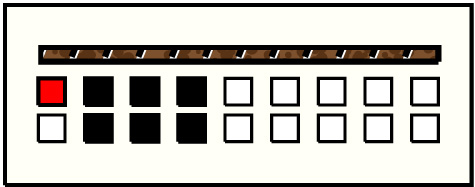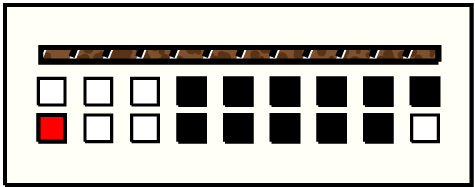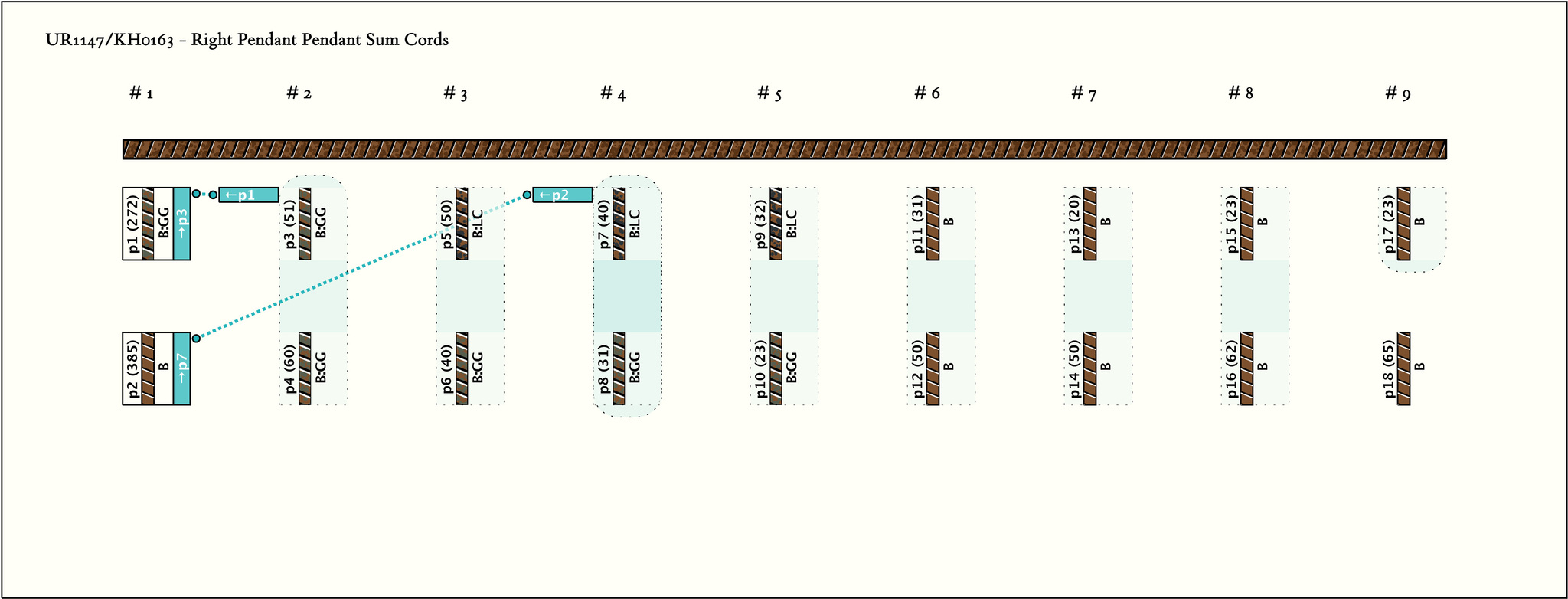UR1147/KH0163 - Pendant Pendant Sums
Drawings:
Right Handed Sums: # Sums = 2, Max # Summands = 11, (Min, Mean, Max) Sum Values = (272, 328, 385)
Click on Image to View Larger
Right Handed Sum Detail: - Click on column name to sort
| # | Color | Sum Schema | Sum Cord | Sum Cord Value | # Summands | Summands |
|---|---|---|---|---|---|---|
| 1 |  | p11, 1 : 272B:GG | 272 | 6 | p3: 51B:GG + p4: 60B:GG + p5: 50B:LC + p6: 40B:GG + p7: 40B:LC + p8: 31B:GG | |
| 2 |  | p21, 2 : 385B | 385 | 11 | p7: 40B:LC + p8: 31B:GG + p9: 32B:LC + p10: 23B:GG + p11: 31B + p12: 50B + p13: 20B + p14: 50B + p15: 23B + p16: 62B + p17: 23B |
Khipu Notes:
Ascher Databook Notes:
- UR1147-UR1149 are associated in that they were all designated by the same Museum number. They were acquired by the Museum in 1907 with provenance Ocucaje. For a comparison of them, see #4 below.
- By spacing, UR1147 is separated into 3 parts. Part 1 consists of 1 pair of pendants, and parts 2 and 3 consist of 4 pairs of pendants each. With the exception of the first pendant in the first pair, each pair in part 2 has the same color pattern: B: LG, B: GG. All pendants in part 3 are the same color, B.
- The values of the pendants in part 1 are related to the sums of the values in parts 2 and 3. They can be interp reted as inexact sums. The sum of the values of the first pendants in the 8 pairs in parts 2 and 3 is 270; the value on the first pendant in the pair in part 1 is 272. Similarly, the sum of the second pendant values is 381 and tha value of the second pendant in the pair in part 1 is 385.
- Comparison of UR1147-UR1149:
- The 3 khipus are similar in grouping. In all of them, the first part sums the following parts. UR1147 and UR1148 are both separated into 3 parts with the second and third parts each containing 4 pairs of pendants. In UR1147, the pair in part 1 sums the 8 pairs in parts 2 and 3 position by position. In UR1148, there are 2 pairs in part 1 so the sums are separate for each part and each position in a pair. UR1149 is also in 3 parts but it differs in the number of groups per part and the number of pendants per group. Again, the values in part 1 are sums, bt only of values in part 2, which in turn contains sums of values in part 3.
- The khipus use the same basic colors. The colors used, alone or in combination, are B, LB, LC, GG, and G0. Three of the 5 are used on UR1148, and UR1147 and UR1149 each use 4 of them.
- The values on the khipus differ in order of magnitude: on UR1147, the values in parts 2 and 3 are 23-65 and the sums in part 1 are 272-385; on UR1148, the values in parts 2 and 3 are 125-638 and the sums in part 1 are 941-2061; and on UR1149, the values in parts 2 and 3 are 0-3410 and the sums in part 1 are 660-21243.
